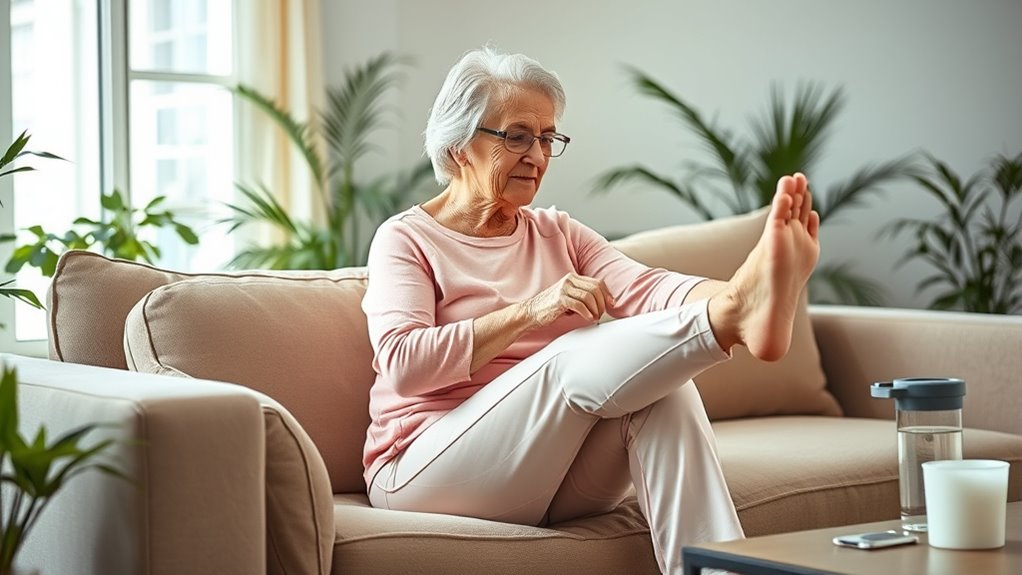You can improve your strength, balance, and flexibility with simple low-impact exercises at home. Try seated leg lifts, torso twists, and leg extensions to boost mobility and joint health. Stand for heel and toe raises or practice ankle rotations to strengthen your lower legs. Incorporate arm circles, chair marching, and opposite arm-leg reaches to enhance coordination and posture. Keep moving gently, and if you keep exploring, you’ll find more ways to stay active safely.
Key Takeaways
- Seated exercises like leg lifts, torso twists, and leg extensions improve flexibility, strength, and joint health with minimal impact.
- Standing movements such as hip abductions, ankle rotations, and balance exercises enhance stability and mobility safely.
- Gentle yoga, stretching, and balance routines support flexibility, reduce fall risk, and can be modified for comfort.
- Shoulder mobility exercises like arm circles and shoulder rolls help maintain range of motion and reduce stiffness.
- Calf raises and ankle strengthening exercises improve lower leg strength, balance, and prevent falls.
Seated Leg Lifts

Seated Leg Lifts are a simple yet effective low-impact exercise that can help seniors strengthen their leg muscles and improve mobility. They are excellent for balance training, helping you develop stability while reducing the risk of falls. To perform, sit upright in a sturdy chair with your feet flat on the floor. Slowly lift one leg straight out, focusing on engaging your thigh muscles, then lower it back down. Repeat with the other leg. This exercise also promotes flexibility exercises in your hips and knees, making daily movements easier. Incorporating seated leg lifts into your routine enhances muscle strength and joint mobility without putting strain on your joints. Additionally, using proper technique and equipment, such as supportive chairs and correct form, can maximize safety and effectiveness. It’s a practical way to stay active and maintain independence at home.
Wall Push-Ups
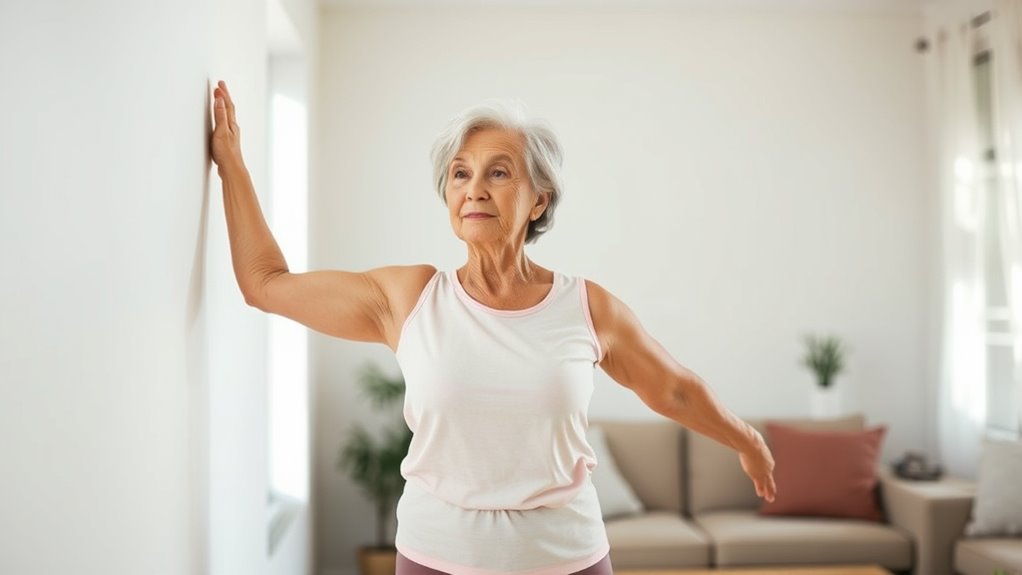
Wall push-ups are a great way to build upper body strength safely. To get the best results, make sure your hands are shoulder-width apart and your body stays straight against the wall. Proper positioning helps prevent injury and makes the exercise more effective. Incorporating automation’s role in business intelligence can help track your progress and adjust your routine accordingly.
Building Upper Body Strength
Building upper body strength is essential for maintaining independence and daily function, and wall push-ups offer a safe, effective way to achieve this. As you do these exercises, focus on your breathing techniques—inhale as you prepare, exhale as you push away from the wall. Incorporating balance exercises alongside wall push-ups can improve stability and coordination, making everyday tasks easier. Keep your feet shoulder-width apart and engage your core to maintain proper posture. Start with a few repetitions, gradually increasing as your strength improves. Remember to breathe steadily throughout each set, avoiding breath-holding. Consistent practice not only builds muscle but also enhances your overall balance, reducing fall risk. Wall push-ups are a simple, low-impact way to strengthen your upper body safely at home. Building confidence in your exercise routine can motivate ongoing participation and improve overall well-being.
Proper Wall Positioning
To get the most benefit from wall push-ups, it’s important to position yourself correctly against the wall. Stand about two feet away, with your feet shoulder-width apart. Keep your body straight, engaging your core, and place your hands flat on the wall at shoulder height. Think of your hands as part of your interior decor—your wall art—adding to the room’s aesthetic. Ascertain your hands are aligned with your shoulders, not too high or low. Keep your elbows slightly bent as you lean in, then push back to the starting position. Proper wall positioning helps prevent strain and maximizes the exercise’s effectiveness. Remember, a well-placed wall can be both functional for exercise and visually appealing as part of your interior decor. Incorporating the right lighting can further enhance your space and motivate your fitness routine.
Heel and Toe Raises

Heel and toe raises are simple yet effective exercises that can help improve balance and strengthen lower leg muscles. By regularly practicing these moves, you enhance your balance and boost ankle flexibility, reducing fall risk. To do heel raises, stand with feet hip-width apart, lift your heels off the ground, hold briefly, then lower. For toe raises, lift your toes while keeping heels on the floor, then lower. Incorporating proper planning for safe exercise can further enhance your routine and prevent injuries. Remember: – Perform slowly to focus on control – Keep your core engaged – Use a sturdy chair or wall for support if needed – Aim for 10-15 repetitions daily – Incorporate into your routine for better stability These exercises are easy, safe, and highly beneficial for maintaining mobility and confidence at home.
Arm Circles
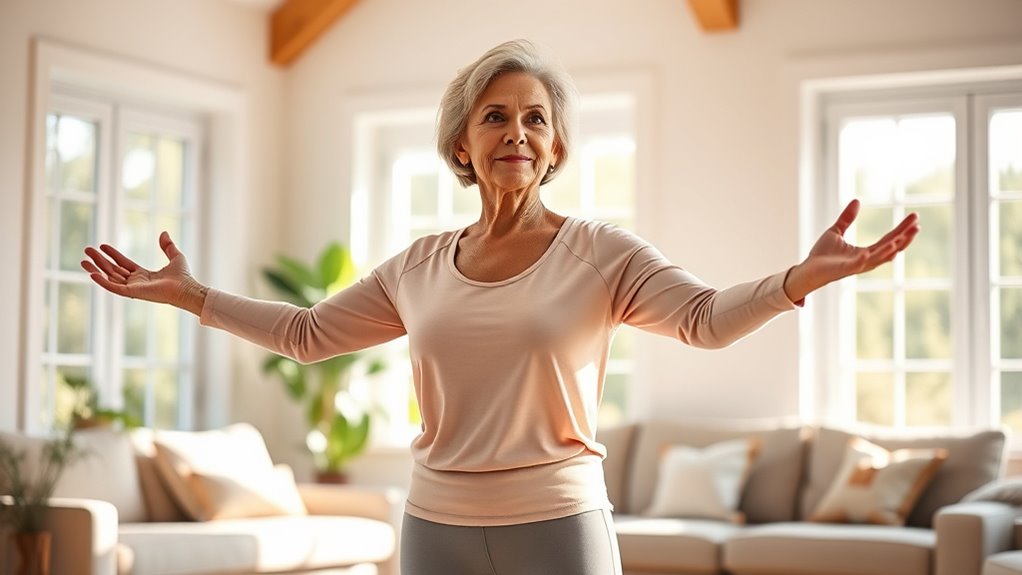
To get the most benefit from arm circles, focus on maintaining proper arm positioning with your arms extended straight out to the sides. Use gentle, controlled circular motions to avoid strain and keep the exercise safe. This way, you can improve flexibility without risking injury. Incorporating mindful awareness during your movements can also enhance your overall meditation practice and promote relaxation.
Proper Arm Positioning
Proper arm positioning is essential for safe and effective arm circles. You want to maintain proper arm alignment to prevent strain and support joint stability. Keep your arms straight but relaxed, avoiding locking your elbows. Focus on moving from your shoulders rather than your wrists or elbows. Ensure your posture stays upright, with shoulders relaxed and down. Remember these key points:
- Keep arms extended in front or to the sides
- Maintain a slight bend in the elbows if needed
- Avoid shrugging or hunching your shoulders
- Move smoothly through the full range of motion
- Stay conscious of arm alignment to protect joints
- Incorporate joint stability techniques to further enhance safety
Proper positioning helps you control the movement and reduce injury risk. Prioritizing joint stability and correct form makes your exercise safer and more beneficial.
Gentle Circular Motion
Gentle circular motions, or arm circles, are a simple and effective low-impact exercise for seniors. They help improve shoulder mobility and increase blood flow. To do arm circles, stand or sit with your arms extended to the sides, moving them in slow, controlled circles. You can add resistance by holding a light resistance band, making the movement even more beneficial. Incorporate tai chi movements to enhance balance and coordination while performing these circles. Focus on smooth, gentle motions to avoid strain. This exercise can be easily integrated into your daily routine and can be combined with resistance band exercises for added strength. Remember to keep your movements controlled and listen to your body, stopping if you feel any discomfort. Using proper technique is essential to prevent injury and maximize the benefits of low-impact exercises.
Chair Marching
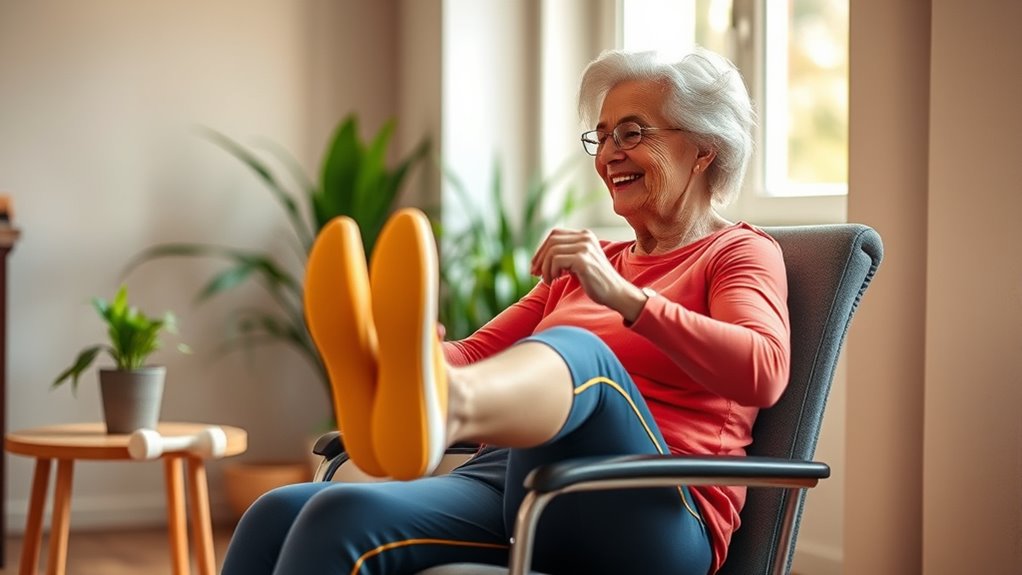
Have you ever considered how simple movements can boost your mobility without putting too much strain on your joints? Chair marching is an easy, effective exercise that enhances balance training and flexibility routines. Sit upright in a sturdy chair, lift one knee toward your chest, then lower it and repeat with the other leg. This engages your leg muscles and improves coordination. To maximize benefits:
- Increase your marching speed gradually
- Focus on smooth, controlled movements
- Keep your core engaged for better stability
- Use arm movements for added cardio
- Perform for 1-2 minutes daily
This low-impact exercise helps maintain joint health, boosts circulation, and supports overall mobility, making it perfect for seniors looking to stay active at home. Incorporating regular movement routines can further enhance overall well-being and prevent stiffness.
Gentle Side Bends

Building on the benefits of chair marching, adding side bends can further enhance your flexibility and spinal mobility. Gentle side bends are simple balance exercises that stretch your obliques and improve posture. To do this safely, sit tall, inhale deeply, and slowly lean to one side, feeling the stretch along your waist. Hold briefly, then switch sides while maintaining steady breathing techniques. This movement helps keep your spine flexible and promotes better balance. You can also incorporate gentle breathing techniques to relax your muscles and increase oxygen flow. Here’s a quick overview:
| Benefit | How it helps |
|---|---|
| Improves flexibility | Keeps your spine mobile |
| Enhances balance | Reduces fall risk |
| Promotes relaxation | Eases tension through breathing |
Being mindful of trust issues and maintaining open communication can also support your emotional well-being during your exercise routines.
Standing Hip Abductions
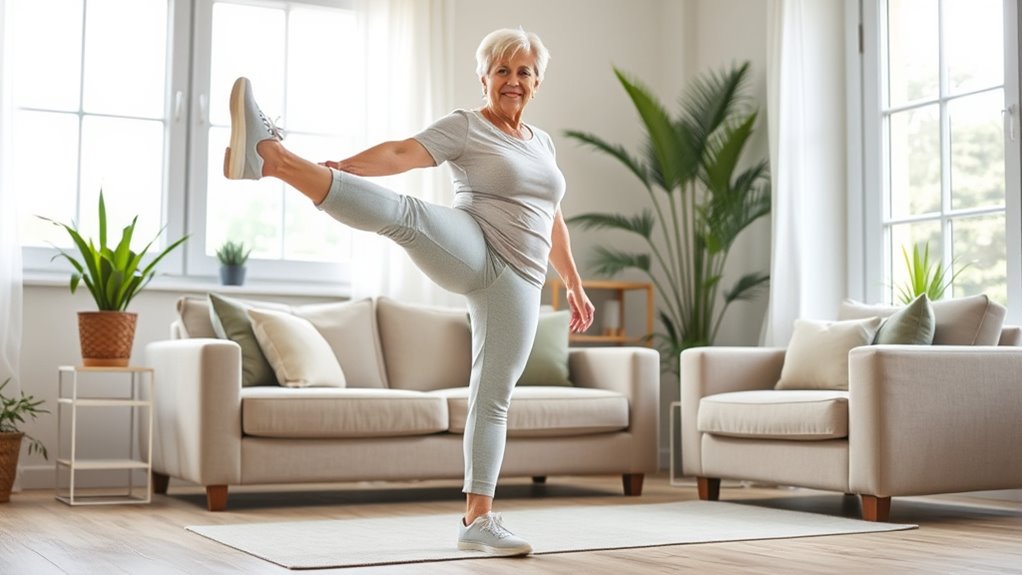
When doing standing hip abductions, keep your feet shoulder-width apart and stand tall to maintain proper posture. Focus on staying balanced by holding onto a chair or wall if needed, ensuring your safety. This exercise helps improve hip mobility and strengthens the muscles that support your hips.
Proper Standing Position
Are you unsure how to stand properly for hip abduction exercises? Maintaining the correct standing position is key for effective balance training and posture correction. Stand tall with your feet hip-width apart. Keep your shoulders relaxed and your spine straight. Engage your core to stabilize your posture. Focus on distributing your weight evenly on both feet. To enhance stability, consider these tips:
- Keep knees slightly bent for balance
- Avoid leaning forward or backward
- Maintain a neutral pelvis position
- Keep your head aligned with your spine
- Ensure your hips are level and not tilted
Correct posture not only improves exercise effectiveness but also reduces the risk of falls. Practice standing with awareness of these points to maximize safety and benefits during hip abduction exercises.
Maintaining Balance Safely
To maintain balance safely during standing hip abduction exercises, focus on engaging your core and keeping a steady stance. Proper posture correction helps you stay stable and reduces the risk of falls. As you lift your leg to the side, imagine a straight line running from your head through your hips; avoid leaning or twisting. Keep your feet firmly planted and distribute your weight evenly. Use a chair or wall for support if needed, especially when starting out. Maintaining good posture and controlled movements are key to fall prevention. Concentrate on slow, deliberate motions, and avoid overextending. This careful approach ensures you strengthen your hips while staying safe and balanced during each exercise.
Enhancing Hip Mobility
Standing hip abductions are an effective way to enhance your hip mobility, allowing for smoother movement and greater flexibility. By regularly practicing this exercise, you improve hip flexibility and promote joint lubrication, which helps prevent stiffness and discomfort. To perform the exercise, stand tall, hold onto a chair for balance, and lift one leg out to the side without tilting your torso. Keep your movements controlled and steady.
Benefits include:
- Increased range of motion
- Strengthened hip muscles
- Reduced risk of falls
- Improved joint lubrication
- Better overall mobility
Incorporating standing hip abductions into your routine can make daily activities easier and more comfortable, especially as you work to maintain healthy hips and prevent mobility issues.
Ankle Rotations
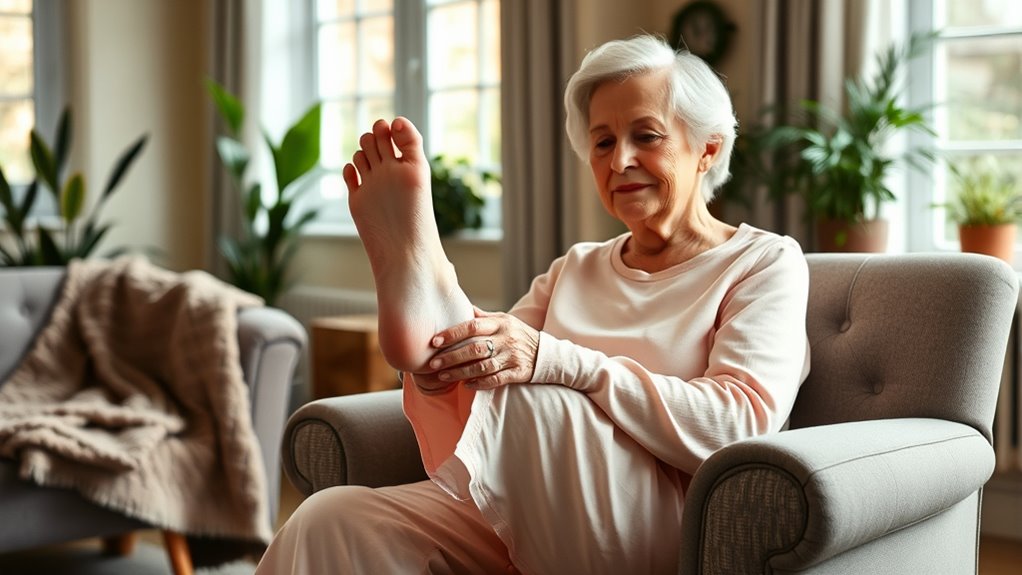
Ankle rotations are a simple yet effective exercise to improve flexibility and stability in seniors. By gently rotating your ankles in circles, you can enhance ankle flexibility, which helps prevent falls and improves balance. To do this, sit comfortably in a chair or on the floor, lift one foot slightly off the ground, and rotate your ankle clockwise for 10-15 seconds. Then, switch to counterclockwise for the same amount of time. Repeat on the other ankle. This exercise is low-impact, easy to incorporate into daily routines, and requires no special equipment. Regular ankle rotations strengthen the muscles around your ankles, increase joint mobility, and contribute to overall stability. Incorporate this simple movement into your daily exercises for better mobility and confidence.
Seated Shoulder Rolls

Seated shoulder rolls are a simple way to boost your shoulder mobility and reduce stiffness. They can also help relieve tension in your neck and upper back. Best of all, they’re easy to do, no matter your fitness level.
Improves Shoulder Mobility
To enhance shoulder mobility safely, seated shoulder rolls are an effective low-impact exercise. This simple movement helps increase flexibility and range of motion, making daily activities easier. When performing shoulder stretches and mobility exercises, focus on controlled, smooth motions. Roll your shoulders forward, then backward, in slow circles. Keep your movements gentle to avoid strain. Regular practice can reduce stiffness and improve posture. Remember to breathe steadily and avoid overextending. Incorporate these tips:
- Keep your back straight and relaxed
- Move within a comfortable range
- Do the exercise in a seated position for stability
- Perform 10-15 rolls in each direction
- Combine with other shoulder stretches for best results
Seated shoulder rolls are an easy way to keep your shoulders flexible and healthy over time.
Relieves Tension and Stiffness
Since tension and stiffness often build up in the shoulders, performing seated shoulder rolls can effectively release this discomfort. These gentle movements help loosen tight muscles, promoting better circulation and flexibility. As you roll your shoulders forward and backward, focus on your breathing to incorporate stress relief and mindfulness exercises into your routine. This mindful awareness helps you stay present, reducing overall tension. Regularly doing these simple shoulder rolls can ease stiffness caused by daily activities or stress, leaving you feeling more relaxed. The movement is easy to do at home, requires no equipment, and can be done anytime you feel tension creeping in. Incorporate these exercises into your daily routine to help keep your shoulders loose and your mind calm.
Simple for All Levels
Simple exercises like seated shoulder rolls are suitable for all fitness levels and require no special equipment. They help improve flexibility routines and support better balance exercises, making them ideal for seniors. You can easily incorporate them into your daily routine to loosen tight shoulders and reduce stiffness. These gentle movements are adaptable, whether you’re just starting or more experienced. To maximize benefits, focus on smooth, controlled motions. Remember, consistency is key. Here are some tips:
- Perform slow, deliberate rolls to enhance flexibility
- Use deep breathing to relax muscles
- Do them seated for stability
- Gradually increase the number of repetitions
- Combine with other simple balance exercises for better results
Seated shoulder rolls are a straightforward way to stay active and improve overall mobility at home.
Step Touches

Step touches are a gentle, effective way to improve your balance and coordination without putting too much strain on your joints. This simple movement helps enhance your overall stability, making it an excellent addition to your balance training routine. To do a step touch, start with your feet hip-width apart, then step to the side with one foot, bringing the other foot to meet it. Repeat in the opposite direction. As you become more comfortable, you can add arm movements or slow down the pace. Incorporating step touches into your daily routine supports flexibility routines by promoting gentle movement and joint mobility. They’re easy to modify for your comfort level, making them a safe, low-impact exercise perfect for seniors looking to stay active at home.
Modified Gentle Yoga Poses
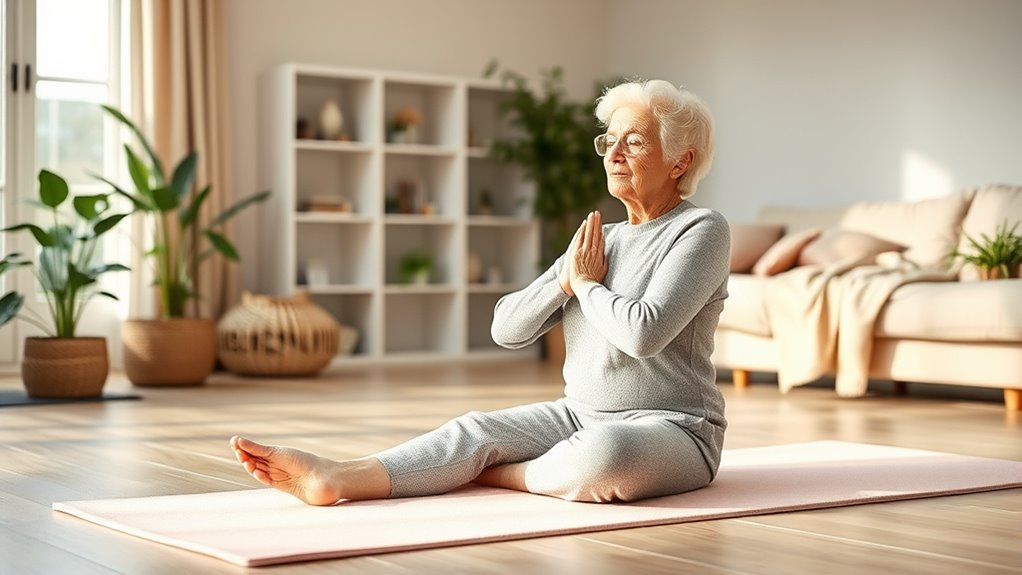
Modified gentle yoga poses are an excellent way for seniors to improve flexibility, balance, and relaxation without putting excessive strain on the body. These poses help enhance balance training and promote mindful breathing techniques, making them ideal for gentle exercise routines. When practicing, focus on slow, controlled movements and deep breaths to maximize benefits. To get started, consider these key points:
- Use sturdy support like chairs or walls for stability
- Incorporate breathing techniques to deepen relaxation
- Modify poses to fit your comfort level
- Prioritize balance training to prevent falls
- Maintain steady, even breaths throughout each pose
Seated Torso Twists
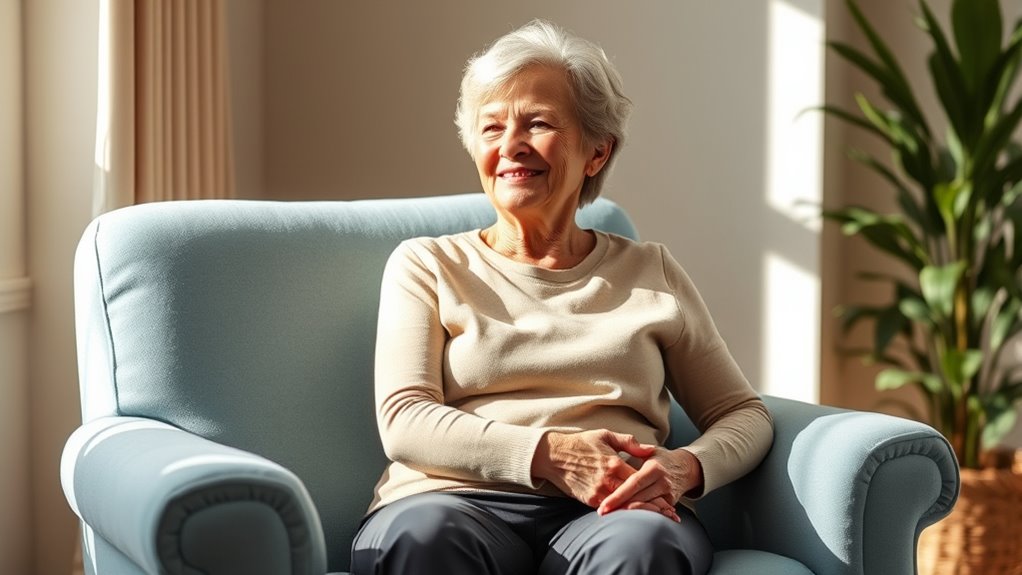
Seated torso twists are an effective gentle exercise that builds rotational flexibility and strengthens your core. To start, sit comfortably in a chair with good chair comfort, keeping your feet flat on the floor and your back straight. Place your hands gently on your shoulders or across your chest. Slowly rotate your upper body to one side, keeping your hips facing forward. Hold briefly, then return to the center before twisting to the other side. Focus on controlled movements to improve torso flexibility without strain. This exercise is safe and easy to do at home, helping to maintain mobility and reduce stiffness. Remember to breathe steadily and avoid over-twisting, especially if you have any back concerns.
Leg Extensions While Sitting
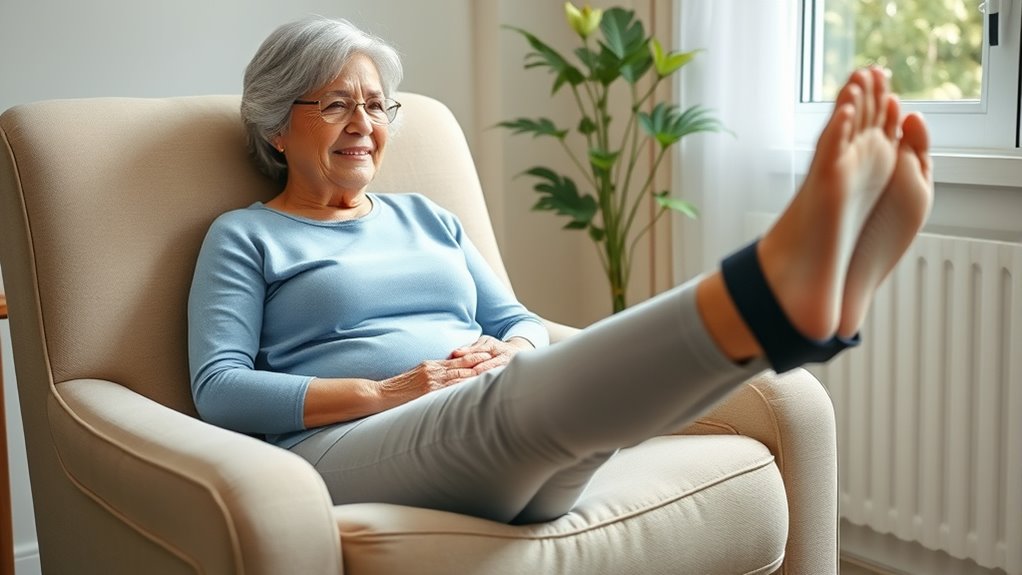
Leg extensions while sitting are a simple and effective way to strengthen your quadriceps without putting stress on your joints. This exercise promotes knee joint health and muscle toning, helping you maintain mobility and strength. To do it, sit upright with your feet flat on the floor. Slowly extend one leg straight out, hold briefly, then lower it back down. Switch legs and repeat.
Remember:
- Keep your back straight for proper posture
- Avoid locking your knees at full extension
- Perform controlled movements, not fast
- Use light ankle weights for added resistance if comfortable
- Breathe steadily throughout the exercise
This exercise minimizes joint strain while targeting thigh muscles, supporting overall knee health and muscle toning.
Standing Calf Raises

Standing calf raises are a simple yet effective exercise to strengthen your lower legs and improve balance. To do this, stand with your feet shoulder-width apart, holding onto a chair or wall for support if needed. Push through the balls of your feet, lifting your heels off the ground and raising your calves. Lower back down slowly and repeat. This exercise helps increase ankle flexibility and strengthens your calf muscles, which are essential for stability and mobility. Regular practice can improve your posture and reduce the risk of falls. Focus on controlled movements, and avoid bouncing or rushing through reps. As you become more comfortable, you can do more repetitions or elevate your toes on a step for added challenge.
Arm and Leg Opposite Reach

Building on your balance and strength, arm and leg opposite reach exercises help improve coordination and stability. These movements promote better balance training and enhance joint flexibility, making daily activities easier. To perform this exercise, stand with feet hip-width apart, then extend one arm forward while lifting the opposite leg behind you. Keep your core engaged and avoid leaning. Repeat on the other side, focusing on controlled movements. This exercise encourages smooth, coordinated motions that boost stability.
- Improves coordination between limbs
- Strengthens core muscles
- Enhances joint flexibility
- Supports better balance
- Reduces fall risk
Incorporate arm and leg opposite reaches into your routine regularly to build resilience and confidence in your movement, all while protecting your joints and maintaining stability.
Frequently Asked Questions
Are These Exercises Suitable for Seniors With Joint Pain?
Yes, joint-friendly routines can be appropriate for seniors with joint pain if you choose gentle exercises tailored for pain management techniques. Always listen to your body, start slowly, and avoid high-impact activities. Consulting your healthcare provider helps guarantee the routines you select support your comfort and health. These routines aim to reduce strain on your joints while keeping you active, promoting better mobility and overall well-being.
How Often Should Seniors Perform These Low-Impact Exercises Weekly?
Like the steady beat of a metronome, your exercise frequency sets the rhythm for a healthy routine. You should aim for at least 150 minutes of moderate activity weekly, spreading it over most days. Incorporate low-impact exercises into your weekly routine, doing them about 3-5 times per week. This balance helps improve flexibility, strength, and overall well-being without overtaxing your joints or body.
Can These Exercises Help Improve Balance and Prevent Falls?
Yes, these exercises can boost your balance and help prevent falls. By focusing on fall prevention and muscle strengthening, you improve stability and coordination. Regularly doing low-impact exercises at home builds strength in key muscles, making you less prone to accidents. Incorporating these routines into your weekly schedule can make a significant difference in your safety and confidence, reducing the risk of falls over time.
What Precautions Should Seniors Take Before Starting These Exercises?
Before starting any exercise, you should prioritize safety by doing warm-up routines to prepare your muscles. It’s important to consult your doctor first, especially if you have health conditions. You might need exercise modifications to suit your fitness level. Always listen to your body, avoid overexertion, and stop if you feel discomfort. Taking these precautions helps prevent injuries and makes your exercise routine safer and more effective.
Are There Any Contraindications for Seniors With Chronic Health Conditions?
When you have a chronic condition, it’s important to contemplate specific contraindications before starting new exercises. You should consult your healthcare provider to understand any limitations. Keep in mind chronic condition considerations like joint pain or cardiovascular issues. Modify exercises as needed, such as reducing intensity or avoiding high-impact moves. Always listen to your body, and stop if you experience discomfort, ensuring safety while staying active.
Conclusion
By incorporating these gentle exercises into your routine, you’ll strengthen your body without feeling overwhelmed—like a leaf floating effortlessly on a calm stream. Staying active at home keeps you flexible, balanced, and energized, helping you enjoy your daily activities more fully. Remember, consistency is key. Even small movements add up, turning your home into a safe space for maintaining your health and independence. So, take a deep breath and start moving today—you’re worth it!
